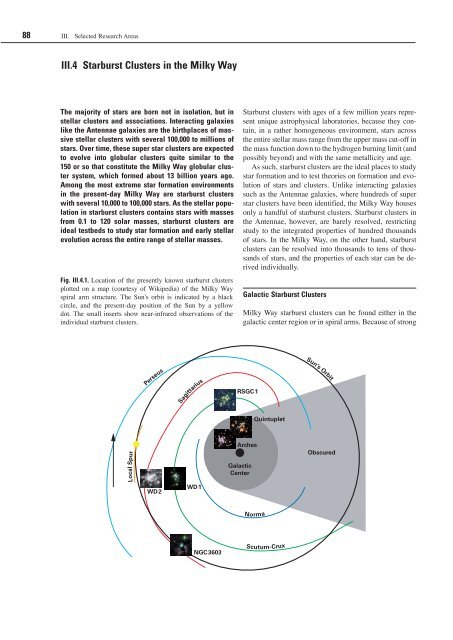Max Planck Institute for Astronomy - Annual Report 2007
Max Planck Institute for Astronomy - Annual Report 2007
Max Planck Institute for Astronomy - Annual Report 2007
Create successful ePaper yourself
Turn your PDF publications into a flip-book with our unique Google optimized e-Paper software.
88 III. Selected Research Areas<br />
III.4 Starburst Clusters in the Milky Way<br />
The majority of stars are born not in isolation, but in<br />
stellar clusters and associations. Interacting galaxies<br />
like the Antennae galaxies are the birthplaces of massive<br />
stellar clusters with several 100,000 to millions of<br />
stars. Over time, these super star clusters are expected<br />
to evolve into globular clusters quite similar to the<br />
150 or so that constitute the Milky Way globular cluster<br />
system, which <strong>for</strong>med about 13 billion years ago.<br />
Among the most extreme star <strong>for</strong>mation environments<br />
in the present-day Milky Way are starburst clusters<br />
with several 10,000 to 100,000 stars. As the stellar population<br />
in starburst clusters contains stars with masses<br />
from 0.1 to 120 solar masses, starburst clusters are<br />
ideal testbeds to study star <strong>for</strong>mation and early stellar<br />
evolution across the entire range of stellar masses.<br />
Fig. III.4.1. Location of the presently known starburst clusters<br />
plotted on a map (courtesy of Wikipedia) of the Milky Way<br />
spiral arm structure. The Sun's orbit is indicated by a black<br />
circle, and the present-day position of the Sun by a yellow<br />
dot. The small inserts show near-infrared observations of the<br />
individual starburst clusters.<br />
Local Spur<br />
Perseus<br />
WD2<br />
Sagittarius<br />
WD1<br />
NGC3603<br />
Starburst clusters with ages of a few million years represent<br />
unique astrophysical laboratories, because they contain,<br />
in a rather homogeneous environment, stars across<br />
the entire stellar mass range from the upper mass cut-off in<br />
the mass function down to the hydrogen burning limit (and<br />
possibly beyond) and with the same metallicity and age.<br />
As such, starburst clusters are the ideal places to study<br />
star <strong>for</strong>mation and to test theories on <strong>for</strong>mation and evolution<br />
of stars and clusters. Unlike interacting galaxies<br />
such as the Antennae galaxies, where hundreds of super<br />
star clusters have been identified, the Milky Way houses<br />
only a handful of starburst clusters. Starburst clusters in<br />
the Antennae, however, are barely resolved, restricting<br />
study to the integrated properties of hundred thousands<br />
of stars. In the Milky Way, on the other hand, starburst<br />
clusters can be resolved into thousands to tens of thousands<br />
of stars, and the properties of each star can be derived<br />
individually.<br />
Galactic Starburst Clusters<br />
Milky Way starburst clusters can be found either in the<br />
galactic center region or in spiral arms. Because of strong<br />
RSGC1<br />
Arches<br />
Galactic<br />
Center<br />
Quintuplet<br />
Norma<br />
Scutum-Crux<br />
Sun’s Orbit<br />
Obscured

















